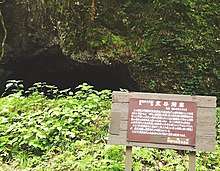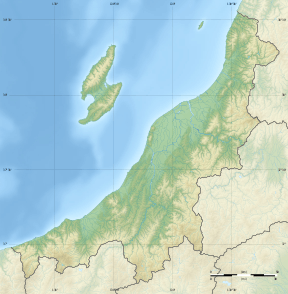Muroya Cave
Muroya Cave (室谷洞窟, Muroya dōkutsu) is a Jōmon period archaeological site consisting of a cave dwelling in what is now part of the town of Aga, Niigata Prefecture in the Hokuriku region of Japan. The site was designated a National Historic Site of Japan in 1980.[1]
室谷洞窟 | |
 Muroya | |
 Muroya Cave  Muroya Cave (Japan) | |
| Location | Aga, Niigata, Japan |
|---|---|
| Region | Hokuriku region |
| Coordinates | 37°32′35″N 139°21′46″E |
| Type | settlement |
| History | |
| Periods | early Jōmon |
| Site notes | |
| Ownership | National Historic Site |
| Public access | Yes |
Overview
The cave is located in the upstream part of the Muroya River, a branch of the Jinna River, and was formed by erosion of a rhyolite outcrop on the river's left bank at an altitude of 218 meters. The cave is approximately three meters in height, seven meters in width and extends for eight meters into the mountain. The interior was excavated from 1953 to 1960, during which time numerous examples of pottery from the earliest stage of the Jōmon Period and the stone tools were discovered. Also found were human bones from the earliest and the early Jōmon period, which were dated to be the oldest found within Niigata Prefecture. The artifacts discovered were designated National Important Cultural Properties in 2000 and displayed at the Nagaoka City Science Museum.
References
- "室谷洞窟" [Muroya dōkutsu] (in Japanese). Agency for Cultural Affairs.
External links
- Aga town home page (in Japanese)